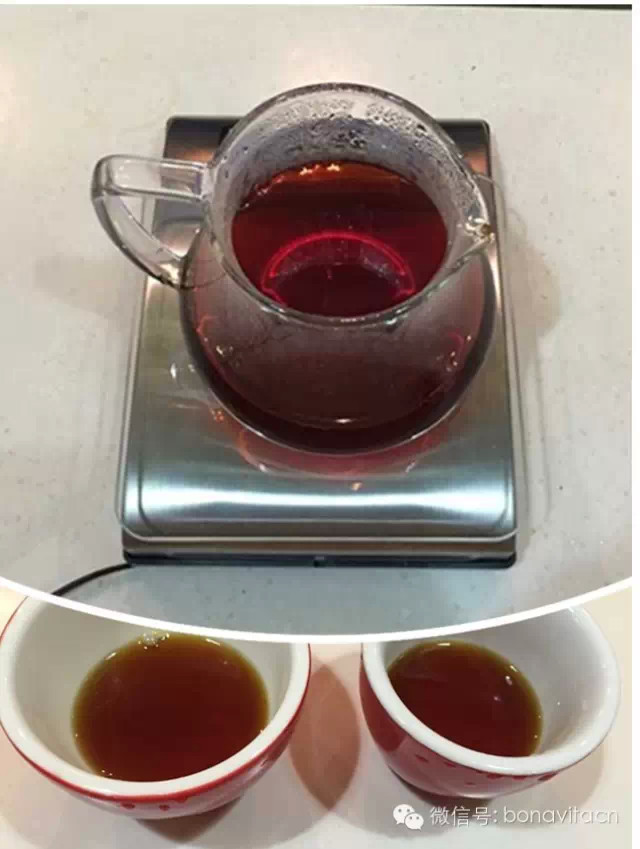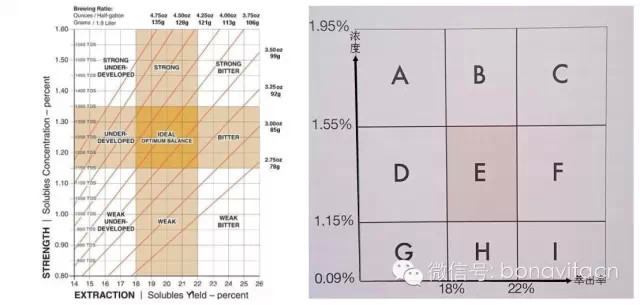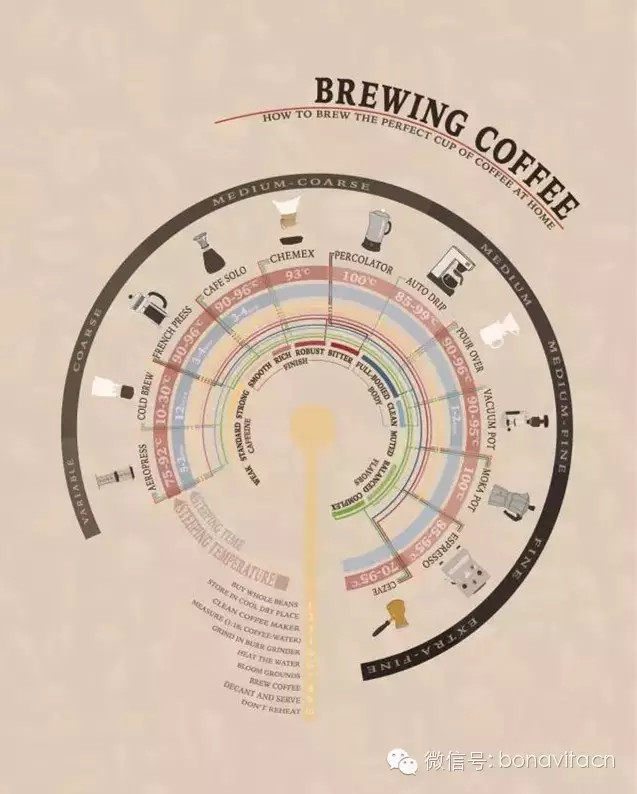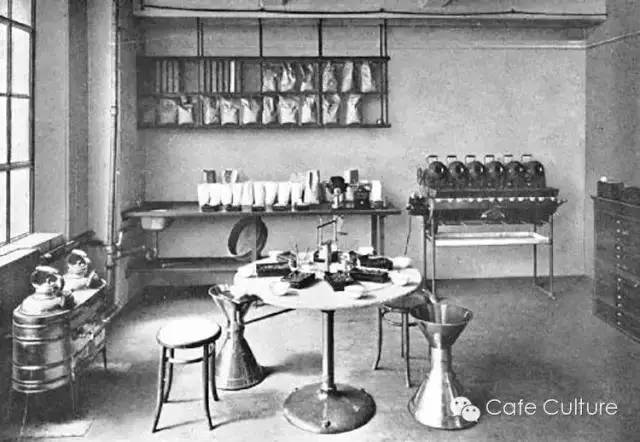Practical skills of making coffee by hand (1) get out!
Through the simple hand-brewing coffee process shared with you in previous issues, the editor believes that everyone should have a preliminary understanding and learning of opponent coffee brewing. In the next few issues, the editor will give you some "practical information". Today, I will first share the Golden Cup guidelines with you. Hee hee!

What is extraction?
From the editor's point of view, extraction is the process in which water absorbs the essence from coffee.
In 1964, Dr. Lockhart reviewed the maiden version of the data with the help of the US military's well-known Midwest Research Center (Midwest Researsh Institute, or MRI) (coffee experts were invited to conduct a cup test to provide professional advice). Finally, the extraction range of the Golden Cup Criterion was raised to 18%-22%, and the concentration range was adjusted to 1.15%-1.35%.
Why 18% Murray 22%?
Each coffee can extract a maximum of about 30% (that is, 70% of xylem cannot be extracted), that is, 10g coffee powder has up to 3G coffee soluble extract, while a cup of delicious coffee, the best extraction rate of coffee, that is, 60% 70% of the maximum soluble matter of 30% coffee is the most suitable extraction, which is less than 60% (less than 18%), and the coffee flavor will show incomplete flavor. On the other hand, if the extraction rate is more than 70% (the extraction rate is more than 22%), the coffee will be overextracted and the coffee will show bitter, spicy and bad taste.
How do we calculate them?
Extraction rate (%) = weight of dissolved matter extracted (g) / weight of coffee powder (g)
TDS/ concentration (%) = weight of dissolved matter extracted (g) / weight of coffee liquid (ml)
The ratio of water to powder in the Golden Cup Criterion is the milliliter of raw cold water extracted in terms of grams of coffee powder.
Brewing ratio refers to the ratio of the amount of coffee powder to the amount of water extracted, which will directly affect the extraction rate of coffee powder and the concentration of coffee liquor. The European and American "Golden Cup Criterion" is based on freshness, fineness and water temperature, time and water flow as the regulation and control tools of the "bubble coffee tube table".
The more powder, the higher the ratio of powder to water, and the higher the concentration of coffee liquid, the easier it is to suppress the extraction rate of coffee powder, resulting in insufficient extraction rate, waste of coffee, and bear the reputation of raging nature. On the other hand, under the fixed amount of powder, the more water, that is, the lower the ratio of powder to water, the lower the concentration, the easier it is to increase the extraction rate, resulting in excessive extraction.
Only in accordance with the "Golden Cup criteria" bubble cooking ratio, Baiwei balance, can enjoy the perfect extraction of delicacy.
Guidelines for brewing golden cups of coffee:

Classic E zone: the extraction rate is 18% 22%, and the concentration is 1.15-1.55%.
This region is located at the intersection of the optimum concentration and the optimum extraction rate, including the target area of the Golden Cup moment of the four mainstream institutions of NEC,SCAA,SCAE,ExtractMOJO. Zone E is recognized as the most classic Baiwei balanced Golden Zone, with the dual advantages of not wasting coffee and sweet taste.
Concentrated but not bitter zone A: the extraction rate is less than 18% and the concentration is higher than 1.55%.
The bubble boiling mode in this area is the most controversial, the concentration is 1.55%, but the extraction rate is below 18%, that is, the combination of insufficient extraction and high concentration, that is, the excess component is deliberately used to increase the coffee concentration to make up for the deficiency of extraction. this method consumes more powder, but the extraction rate is too low, resulting in excessive coffee ingredients remaining in the coffee grounds, which is often criticized as a waste.
The concentration in area B is on the high side, and the flavor in area C is very thick and bitter, and the development of flavor in area D is insufficient.
The miscellaneous bitterness in the F area pays more attention to the weakness of the G area, the light elegance of the H zone and the black heart bite of the throat in the I zone.
To be continued!
Source: Bonavita in China
Important Notice :
前街咖啡 FrontStreet Coffee has moved to new addredd:
FrontStreet Coffee Address: 315,Donghua East Road,GuangZhou
Tel:020 38364473
- Prev

High-quality coffee learning coffee utensils great literacy
Use the right coffee utensils to reflect the characteristics of different coffee beans incisively and vividly. How to choose a suitable coffee utensil? What is the appropriate temperature and time to make coffee? A picture tells you the answer! Philharmonic pressure time: 0.5-2 minutes temperature: 75-92 degrees Celsius caffeine, sugar, alcohol, flavor: medium, rich, pure, balanced cold extraction kettle time: 12
- Next

Professional and technical paste 4 methods to teach you to identify the quality of raw beans
Purchasing raw beans is one of the most important and interesting jobs for every coffee roaster. Picking raw beans is like picking your favorite candy in a candy store. The average home baker can buy coffee beans according to the name, origin and product description of raw beans. Even if you buy it wrong, the loss is no more than $5, which is purely a lesson. But for real majors,
Related
- What is the meaning of lactic acid fermentation with coffee bean treatment?
- How to judge the state of foam by sound?
- How does the latte pull out the unicorn pattern? Come to get for a little trick to improve the flower pull!
- Will flower pulling affect the taste of the latte?
- Do you know the history of coffee?
- The difference between honey treatment and sun washing what is raisin honey treatment?
- What kind of milk can a novice use to make coffee foam to keep the foam longer? The correct method and skills of milking tutorial sharing
- Why do washed coffee beans taste sour? Flavor characteristics of washed Coffee
- Introduction to the skill of how to practice the size and height of water injection around the circle of hand-brewed coffee
- How do beginners practice coffee flower drawing from scratch?

